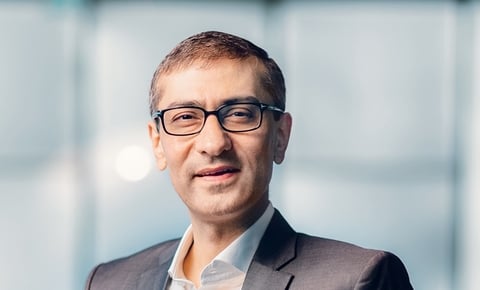LOS ANGELES—Although research has shown Ericsson increasing its lead over Nokia in the U.S. wireless equipment market, Nokia CEO Rajeev Suri says he’s fine with how Nokia is tracking in the North American market—and its end-to-end capabilities give it an important edge in 5G.

“So far, we’re looking very good in 5G. I’m very pleased,” he said on the sidelines of Mobile World Congress Americas 2018 (MWCA18).
In fact, during Nokia’s second-quarter conference call in July, Suri said that despite losing a small number of Verizon markets to a competitor, he sees no overall footprint loss in North America and any suggestion that Nokia is losing share as a result of some fundamental issue of product competitiveness is simply incorrect.
RELATED: Nokia CEO admits to losing 'small number' of Verizon markets
Nokia is supplying 5G gear to Verizon, AT&T and T-Mobile, and it has been a longtime supplier to Sprint. Notably, this past summer, T-Mobile announced a landmark $3.5 billion agreement with Nokia on 5G, where Nokia is supplying its end-to-end 5G technology, software and services to T-Mobile.
That end-to-end capability was the big driver behind Nokia’s acquisition of Alcatel-Lucent, which closed in November 2016. “Our benefit is end-to-end," Suri told FierceWirelessTech. "End-to-end matters much, much more in 5G than it did in past wireless technologies,” and operators need to invest in backhaul, fronthaul, mid-haul, as well as upgrade routing and add software for mobility and fixed wireless.
Compared to a company that is only a radio player, Nokia can provide fixed wireless through a number of ways, including fiber, Nokia’s FastMile solution and 60 GHz, or WiGig. In addition, it’s got the SDN, analytics and more. “It’s a very broad portfolio,” he said.
Suri’s message at MWC in Barcelona this past February was that the U.S. and China were neck-and-neck in the race to 5G and the U.S. needed to get more aggressive about spectrum.
Since then, the U.S. has demonstrated that it is moving first. Verizon announced it will offer a fixed 5G commercial service in parts of four markets starting Oct. 1, and AT&T plans to begin introducing mobile 5G to customers in a dozen cities this year.
“The U.S. is really moving fast,” he said. Operators are making vendor decisions on 5G New Radio, announcing world firsts, and Nokia itself has announced a number of world firsts with various operators. “I think at this point, the U.S. is going first,” in terms of real commercial rollouts and not trials.
The next countries will be South Korea, Japan, China and some middle Eastern and Nordic countries, including Nokia’s homeland of Finland—those are the lead countries over the next year with commercial rollouts starting, he said.
RELATED: Nokia CEO: U.S., China lead 5G race, but U.S. needs to make midband spectrum available
One area where Nokia is distinctly different from its fellow European competitor Ericsson is in the area of the Open RAN movement. Nokia is involved with a number of open source initiatives, where Ericsson has taken a decidedly less aggressive approach, although it’s possible that may change.
“We’re in favor of Open RAN because it allows our operator customers to move fast. You can interoperate between players,” Suri said. Operators want to mix and match products, and while that may sound like it’s not in the best interest of an end-to-end player like Nokia, it’s also an opportunity. If an operator wants to bring Nokia into a market dominated by a competitor, that’s a win.
Traditionally, wireless operators have awarded contracts to infrastructure vendors on a market-by-market basis. However, in a more open ecosystem, an operator conceivably could bring in more than one vendor. Whether that makes economic sense in a traditional market-by-market approach is yet to be seen, but that would be made possible with a more open architecture.
Suri said he thinks the whole industry needs to be more cloudlike. As a leading vendor, Nokia has embraced openness. “There’s always a risk, but I don’t want our customers to have vendor lock-ins. I want us to compete on innovation and that’s why. If you want to mix and match, you should be able to mix and match.
“It’s also an opportunity for us. We can take more market share. If you’ve got better products, which we think we do … Nokia is the only end-to-end portfolio company in the network space that plays in all the markets in the world,” he said. Huawei is an end-to-end player, but it’s been essentially locked out of the Tier 1 wireless operator market in the U.S., for example.
While the U.S. is in the 5G lead, Suri used part of his keynote at MWCA18 to remind everyone that South Korea, Japan and China are coming up quickly in the 5G rearview mirror, and similar to what he said at MWC in February, the U.S. needs to make more midband spectrum available. Part of that means finalizing the rules at the FCC for the 3.5 GHz Citizens Broadband Radio Service spectrum, and the other big initiative is getting the 3.7-4.2 GHz, also known as the C-Band, ready for wireless operators.
Suri and other Nokia executives met earlier this year with FCC commissioners, and Suri said he intends to continue working with the FCC on that messaging. “I think they get it,” he said. “We just need to keep auctions moving.”
